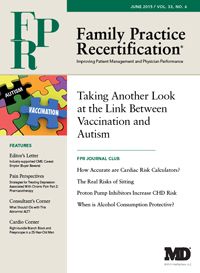Publication
Article
Family Practice Recertification
Antidepressants for Analgesia
Author(s):
While treating our patients' depression is a crucial aspect of sound pain management practice in primary care, the analgesic effects of certain antidepressants, particularly for select types of chronic pain, should also not be underestimated.

In last month’s Pain Perspectives, I addressed the art of effective antidepressant therapy in treating the depression that is invariably an aspect of chronic pain syndromes. While treating our patients’ depression is a crucial aspect of sound pain management practice in primary care, the analgesic effects of certain antidepressants, particularly for select types of chronic pain, should also not be underestimated.
The first randomized controlled trial of an antidepressant for the treatment of a chronic pain condition appeared in the literature in 1964, demonstrating that amitriptyline was effective in treating chronic tension headaches (1). This study instigated a myriad of investigations of tricyclic antidepressants (TCAs) in the treatment of a wide variety of chronic pain conditions, including “rheumatic pain” (2), trigeminal neuralgia (3), painful mono- and polyneuropathies (4), chronic low back pain (5), postherpetic neuralgia (6), chronic neck pain (7), painful diabetic neuropathy (8), and pain associated with multiple sclerosis (9).
While tricyclic antidepressants have considerable empirical support as an analgesic, dosing questions remain difficult to answer. Although lower dosages of tricyclics are associated with less severe side effects that may cause their discontinuation by patients (10), recent increases in our understanding of pharmacogenomic differences (11) suggest that each patient will have his/her own unique response to these medications. Accordingly, the “art” of using tricyclic antidepressants involves “starting low and going slow”, taking both analgesic efficacy and tolerability into account. While numerous tricyclic antidepressants have demonstrated efficacy for analgesia, amitriptyline has been determined the most commonly prescribed for this purpose (12).
The other class of antidepressants found to have clear analgesic efficacy are serotonin—norepinephrine reuptake inhibitors (SNRIs), most notably duloxetine. Initially, premarket studies suggested that duloxetine demonstrated clinical utility in relieving pain in patients suffering from major depression. During this time there were questions voiced regarding the drug’s analgesic qualities in non-depressed patients with pain (13).
However, subsequent investigations provided support for duloxetine’s analgesic efficacy in the treatment of disorders including fibromyalgia (14), painful diabetic neuropathy (15), pain associated with Parkinson’s disease (16), knee pain due to osteoarthritis (17), chronic low back pain (18), central neuropathic pain caused by spinal cord injury or stroke (19), trigeminal neuralgia (20), and pain associated with multiple sclerosis (21). Importantly, data indicate that patients with chronic low back pain treated with duloxetine are less likely to use opioid analgesics as a part of their treatment regimens (22).
Another SNRI, venlafaxine, has been investigated and utilized in the treatment of various types of chronic pain — although its evidence for efficacy pales compared to that of duloxetine. Given the paucity of high quality data, it is not surprising that a 2013 Cochrane Review failed to support the efficacy of venlafaxine in the treatment of chronic pain following surgery (23).
Finally, a newer SNRI, milnacipran, has demonstrated some efficacy in treating fibromyalgia (24), and orofacial pain (25), although the authors of a 2012 Cochrane Review on its use in treating neuropathic pain and fibromyalgia concluded that it was only minimally more effective than placebo and was associated with high levels of adverse events (26).
It is also important to note that the authors of a Cochrane Review (27) concluded that side effects of duloxetine are minor, with serious adverse effects rare. This is in stark contrast to the beleaguering side effect profile of TCAs, and result in TCAs having the highest percentage of patients with chronic neuropathic pain discontinuing therapy when compared in a meta-analysis to other antidepressants and anticonvulsants (28). While data have demonstrated the cost-effectiveness of duloxetine in treating chronic pain (29), insurers in the United States unfortunately often refuse to pay for it — as it is more expensive than generic TCAs.
In conclusion, the currently available data provide the highest level of support for the efficacy, tolerability, and safety of duloxetine as an anti-depressant used for analgesia. This is not to say, however, that all patients with chronic pain will respond positively to this medication. In some cases (including those in which insurers refuse to pay for duloxetine), clinicians will be compelled to rely upon TCAs, and be more vigilant regarding side effects and adverse events. Irrespective, I hope that this column helps you as primary care providers understand that we have extremely effective non-opioid agents that can expand your chronic pain management armamentaria.
References
1) Lance JW, Curran DA. Treatment of chronic tension headache. Lancet 1964; 1(7345):1236-1239.
2) Gringras M. A clinical trial of Tofranil in rheumatic pain in general practice. J Int Med Res. 1976;4(2 Suppl):41-49.
3) Carasso RL, Yehuda S, Streifler M. Clomipramine and amitriptyline in the treatment of severe pain. Int J Neurosci. 1979;9:191-194.
4) Langohr HD, Stöhr M, Petruch F. An open and double-blind cross-over study on the efficacy of clomipramine (Anafranil) in patients with painful mono- and polyneuropathies. Eur Neurol. 1982;21:309-317.
5) Alcoff J, Jones E, Rust P, Newman R. Controlled trial of imipramine for chronic low back pain. J Fam Pract. 1982;14:841-846.
6) Watson CP, Evans RJ, Reed K, Merskey H, Goldsmith L, Warsh J. Amitriptyline versus placebo in postherpetic neuralgia. Neurology 1982;32:671-673.
7) Hameroff SR, Cork RC, Scherer K, et al. Doxepin effects on chronic pain, depression and plasma opioids. J Clin Psychiatry 1982;43:22-27.
8) Kvinesdal B, Molin J, Frøland A, Gram LF. Imipramine treatment of painful diabetic neuropathy. JAMA 1984;251:1727-1730.
9) Clifford DB, Trotter JL. Pain in multiple sclerosis. Arch Neurol. 1984;41:1270-1272.
10) Richeimer SH, Bajwa ZH, Kahraman SS, Ransil BJ, Warfield CA. Utilization patterns of tricyclic antidepressants in a multidisciplinary pain clinic: a survey. Clin J Pain 1997;13:324-329.
11) Rodieux F, Piguet V, Berney P, Desmeules J, Besson M. Pharmacogenetics and analgesic effects of antidepressants in chronic pain management. Pers Med. 2015;12:163-175.
12) Fishman SM, Teichera D. Challenges and choices in drug therapy for chronic pain. Cleve Clin J Med. 2003;70:119-138.
13) Leo RJ, Barkin RL. Antidepressant use in chronic pain management: is there evidence of a role for duloxetine? Prim Care Companion J Clin Psychiatry 2003;5:118-123.
14) Arnold LM, Lu Y, Crofford LJ, et al. A double-blind, multicenter trial comparing duloxetine with placebo in the treatment of fibromyalgia patients with or without major depressive disorder. Arthritis Rheum. 2004;50:2974-2984.
15) Goldstein DJ, Lu Y, Detke MJ, Lee TC, Iyengar S. Duloxetine vs. placebo in patients with painful diabetic neuropathy. Pain 2005;116:109-118.
16) Djaldetti R, Yust-Katz S, Kolianov V, Melamed E, Dabby R. The effect of duloxetine on primary pain symptoms in Parkinson disease. Clin Neuropharmacol. 2007;30:201-205.
17) Chappell AS, Ossanna MJ, Liu-Seifert H, et al. Duloxetine, a centrally acting analgesic, in the treatment of patients with osteoarthritis knee pain: a 13-week, randomized, placebo-controlled trial. Pain 2009;146:253-260.
18) Skljarevski V, Desaiah D, Liu-Seifert H, et al. Efficacy and safety of duloxetine in patients with chronic low back pain. Spine 2010;35:E578-585.
19) Vranken JH, Hollmann MW, van der Vegt MH, et al. Duloxetine in patients with central neuropathic pain caused by spinal cord injury or stroke: a randomized, double-blind, placebo-controlled trial. Pain 2011;152:267-273.
20) Anand KS, Dhikav V, Prasad A, Shewtengna A. Efficacy, safety and tolerability of duloxetine in idiopathic trigeminal neuralgia. J Indian Med Assoc. 2011;109:264-266.
21) Vollmer TL, Robinson MJ, Risser RC, Malcolm SK. A randomized, double-blind, placebo-controlled trial of duloxetine for the treatment of pain in patients with multiple sclerosis. Pain Pract. 2014;14:732-744.
22) Andrews JS, Wu N, Chen SY, Yu X, Peng X, Novick D. Real-world treatment patterns and opioid use in chronic low back pain patients initiating duloxetine versus standard of care. J Pain Res. 2013;6:825-835.
23) Chaparro LE, Smith SA, Moore RA, Wiffen PJ, Gilron I. Pharmacotherapy for the prevention of chronic pain after surgery in adults. Cochrane Database Syst Rev. 2013;7:CD008307.
24) Clauw DJ, Mease P, Palmer RH, Gendreau RM, Wang Y. Milnacipran for the treatment of fibromyalgia in adults: a 15-week, multicenter, randomized, double-blind, placebo-controlled, multiple-dose clinical trial. Clin Ther. 2008;301988-2004.
25) Ito M, Kimura H, Yoshida K, Kimura Y, Ozaki N, Kurita K. Effectiveness of milnacipran for the treatment of chronic pain in the orofacial region. Clin Neuropharmacol. 2010;33:79-83.
26) Derry S, Gill D, Phillips T, Moore RA. Milnacipran for neuropathic pain and fibromyalgia in adults. Cochrane Database Syst Rev. 2012;3:CD008244.
27) Lunn MP, Hughes RA, Wiffen PJ. Duloxetine for treating painful neuropathy or chronic pain. Cochrane Database Syst Rev. 2009;4:CD007115.
28) Rudroju N, Bansal D, Talakokkula ST, et al. Comparative efficacy and safety of six antidepressants and anticonvulsants in painful diabetic neuropathy: a network meta-analysis. Pain Physician 2013;16:E705-714.
29) Wielage RC, Bansal M, Andrews JS, Wohlreich MM, Klein RW, Happich M. The cost-effectiveness of duloxetine in chronic low back pain: a US private payer perspective. Value Health 2013;16:334-344.






